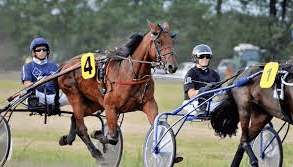What Are The Rules Of Harness Racing?

Harness racing is a popular sport that combines horsemanship and strategy, captivating audiences with its thrilling races. To ensure fair play and the safety of both horses and drivers, harness racing has established a set of rules that govern every aspect of the sport. These rules not only dictate the fundamental aspects of trotting or pacing but also aim to prevent interference and intimidation among competitors. By adhering to these regulations, harness racing offers an exhilarating experience for both participants and spectators alike.
The first rule that forms the foundation of harness racing is whether it will be conducted at a trot or pace. This distinction refers to the specific gait in which the horse moves during the race. In trotting races, horses move forward by lifting their diagonally opposite legs simultaneously, while in pacing races, they move their legs on each side simultaneously. The choice between trotting or pacing depends on various factors such as breed characteristics, individual horse abilities, and regional preferences. Regardless of which gait is chosen, it is essential for all participants to abide by this fundamental rule to maintain uniformity throughout the sport.
Apart from determining the gait used in races, another crucial aspect addressed by the rules of harness racing is avoiding interference and intimidation among competitors. Fair play is paramount in this sport as any form of hindrance caused intentionally or unintentionally can significantly impact the outcome of a race. Drivers must maneuver their horses skillfully while maintaining proper spacing between themselves and other competitors. Any attempt to impede another driver’s progress or create dangerous situations through reckless driving can result in penalties or disqualification. These regulations ensure equal opportunities for all participants and enhance safety measures during races.
Trot or Pace: The Fundamental Rule of Harness Racing
The fundamental rule of harness racing is the distinction between trotting and pacing, where horses move their legs in a synchronized manner to create an elegant and precise motion as they glide across the track.
Trotting is a technique in which the horse’s front and back legs on each side move together, creating a diagonal gait. This requires careful coordination and balance from both the horse and driver.
On the other hand, pacing involves the horse moving its legs on each side simultaneously, resulting in a lateral gait. Pacing strategy is often considered faster than trotting due to its smoother rhythm, but it requires specific training and conditioning for both the horse and driver.
The choice between trotting or pacing depends on various factors such as the horse’s natural inclination, physical ability, and racing conditions.
Harness racing enthusiasts appreciate both styles for their unique characteristics and techniques that contribute to the excitement of this exhilarating sport.
Avoiding Interference and Intimidation: Fair Play in Harness Racing
Avoiding interference and intimidation is crucial for maintaining fair play in the sport of harness racing. Sportsmanship and ethics are essential in ensuring fair competition among participants. Harness racing requires all drivers to adhere to specific rules and regulations that promote a level playing field.
Penalties and disqualifications serve as consequences for any instances of interference or intimidation during a race. These penalties may include fines, suspensions, or even permanent bans from the sport.
By enforcing these rules, harness racing organizations aim to create an environment where all participants can compete fairly and safely. Upholding the principles of sportsmanship and ethics not only ensures fair competition but also enhances the overall experience for both drivers and spectators alike, fostering a sense of integrity within the sport.
Ensuring a Thrilling and Safe Race: The Rules of Harness Racing
Ensuring a thrilling and safe race requires participants to navigate the fine line between pushing the envelope and going overboard, like walking on thin ice.
One crucial aspect of harness racing is the importance of equipment. Horses are required to wear specific gear, such as a bridle, bit, and saddle pad. These pieces of equipment not only provide comfort and protection for the horse but also contribute to maintaining control during the race.
Additionally, judges play a vital role in enforcing the rules of harness racing. They closely monitor each race to ensure that all participants adhere to the established regulations. Judges have the authority to penalize any infractions or violations committed by drivers or horses, including interference or breaking stride. Their presence helps maintain fairness and integrity in harness racing competitions, ensuring an exciting yet safe environment for both horses and drivers alike.
Frequently Asked Questions
How are the horses trained for harness racing?
Training techniques for harness racing involve systematic methods to develop horses’ strength, stamina, and speed. Training regimens include long distance workouts, interval training, and specific exercises like jogging and trotting. Specialized equipment such as harnesses and sulky carts are used during training sessions.
What is the minimum age for horses to participate in harness racing?
The minimum age for horses to participate in harness racing varies depending on the jurisdiction, but it typically ranges from two to three years old. Horses undergo specialized training methods that focus on conditioning and developing their trotting or pacing abilities.
Are there any restrictions on the jockeys’ weight in harness racing?
Jockeys’ weight restrictions are in place in harness racing to ensure the safety of both the jockey and the horse. These restrictions aim to prevent excessive weight that could potentially harm the horses and impact their performance on the track.
How are the harness racing tracks maintained?
Harness racing tracks are meticulously maintained to ensure the safety of both horses and drivers. Regular maintenance includes grading the track surface, removing debris, and maintaining proper moisture levels. Safety measures such as padding on walls and fences further enhance the overall track condition.
Are there any specific rules regarding the use of whips or other aids during a race?
Whip regulations and the use of aids in harness racing are subject to rules set by regulatory bodies. These rules aim to ensure the welfare of horses, with limitations on whip usage and specific guidelines for other aids used during races.
Conclusion
In conclusion, harness racing is a thrilling and competitive sport that follows a set of rules to ensure fair play and safety for both horses and drivers.
The fundamental rule of distinguishing between trotting and pacing helps maintain an even playing field and allows for different strategies to be employed by the competitors.
Avoiding interference and intimidation is crucial in harness racing, as it ensures that each horse has a fair chance of winning without being hindered by other participants.
By enforcing strict regulations on whip usage, track conduct, and equipment standards, harness racing organizations strive to create an environment where every participant can showcase their skills while minimizing the risk of accidents or injuries.
As the old saying goes, “Fair play is not only essential in sports but also in life.”This adage holds true in harness racing as well, where abiding by the rules promotes fairness among competitors and fosters respect within the community.
Harness racing enthusiasts can take solace in knowing that this sport operates under a comprehensive set of guidelines designed to promote integrity and protect the welfare of all involved parties.
By understanding these rules and appreciating their importance, spectators can better appreciate the strategy, skill, and athleticism displayed by both equine athletes and human drivers during each exhilarating race.
With its rich history spanning centuries, harness racing continues to captivate audiences worldwide with its unique blend of speed, precision, and camaraderie amongst participants – making it a truly remarkable sport deserving of admiration.



